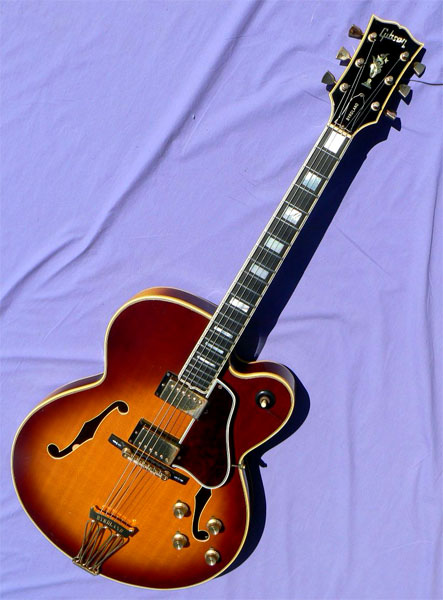 c. 1969 Gibson Byrdland
c. 1969 Gibson ByrdlandHome / Instruments /Accessories / Ordering / Tips / Friends
archtop.com
 c. 1969 Gibson Byrdland
c. 1969 Gibson Byrdland
Status: Pricing and hold status for all instruments currently available is shown on our Instruments page here. If this instrument does not appear on the Instruments page it has been sold, and is no longer available. Photos and descriptions of Previously Sold instruments may be found here. To be notified of examples of this model or similar instruments in the future, please contact [email protected],. Please be specific on which instrument(s) you're looking for, and we'll be happy to contact you as soon as they become available.
Serial #: 952347
Body size at lower bout: 17". Scale length: 23 1/2" Nut Width: 1 10/16" Body depth: 2 1/4"
Materials: Solid carved bookmatched spruce top; solid flame maple back and sides; solid 3 piece maple neck; solid ebony fingerboard; L-5 style block mother of pearl fingerboard inlay and flowerpot peghead inlay; 7 ply top binding, triple bound back and neck, bound f-holes.
Hardware: Original gold hardware includes twin Gibson Pat. sticker humbucking pickups; Kluson Sealfast tuners with tulip keys; loop style trapeze tailpiece with engraved crossbar; compensated Tune-o-matic bridge with inlaid ebony foot; 3 way control switch. Original black bonnet knobs in case, with extra gold reflector cap knobs installed; vintage correct hand bound 5-ply tortoise pickguard.
Notes: It was a disc jockey convention in Nashville, and the year was 1955. Gibson, Inc. had a booth demonstrating their new offerings, and ace session guitarists Hank Garland and Billy Byrd were sampling the merchandise. Then, according to Garland, Gibson rep Clarence Havenga asked the fateful question: "What would you like in a guitar that we don't already have?" By the time the three had finished brainstorming, a new guitar was born.
Christened the Byrdland after its co-creators, this innovative model was based on the L-5CES, with its solid carved spruce and maple body, block and flowerpot inlay, and multi-ply binding right down to the pointed end of the ebony fingerboard. But Hank and Billy wanted more. First, both the scale length and nut width were shortened, to create Gibson's fastest neck ever, specifically tailored to facilitate stretch chord voicings and lightning fast lead runs. Special pickups had to be fabricated to accommodate the narrower pole spacing as well. And finally, Hank had been playing a custom Stromberg with a slimmer body depth, and he asked Havenga to match it. The traditional body depth of Gibson archtops had been unchanged since the Loar era, but by April 4th 1955, Gibson ledgers recorded the creation of four L-5CES guitars with the handwritten designation 'special thin model'. Thus did the Byrdland become Gibson's first ever thinline guitar, pioneering one of the most popular and influential body designs of the modern era, and Hank and Billy's brainchild has remained in the catalog to this day.
This fine orange-label Kalamazoo guitar has twin original gold Patent Sticker pickups, and a solid carved quartersawn spruce soundboard. Significantly, this gleaming instrument was built with a solid carved flame maple back as well, in contrast to the many laminate back examples built during this decade. Original gold hardware includes the engraved Byrdland tailpiece, Tune-o-matic bridge, and genuine Kluson Sealfast tuners, long unavailable on the market. A set of aged gold reflector cap knobs are fitted to the controls, with the original black "witch hat" knobs included in the case. The classic 60's sunburst finish is all original, and remarkably free of pick, thumb or fingerboard wear. A wood scratch near the selector switch and a patch of buckle rash on the back are the principal signs of play in this otherwise very well kept instrument.
Ambiguities in Gibson serial numbers can make precise dating on guitars from this era quite challenging. The orange oval label, no-volute neck, and highly flamed body all indicate a guitar built in the pre-Norlin era. According to Duchossoir, the no-dot Gibson logo was introduced in mid '68, and the Venetian cutaway body re-apppeared in early '69. The peghead bears a 'Made in USA' stamp, which may indicate either a guitar built for export, or a guitar completed earlier but not actually shipped until late '69 or '70. In any event, we believe this guitar would have been one of the very first built with the resurrected Venetian cutaway and solid carved back.
A vintage correct hand bound tortoise pickguard is installed, and the case is the original deluxe black arched Gibson logo hardshell in splendid condition. The original medium jumbo frets are in great shape, with smooth low action over a fast, comfy light D neck with solid ebony fingerboard. The tone is warm, rich and woody, with the resonance only decades of age can impart. A rare and striking example of a landmark in the evolution of the modern electric guitar. One only: call now.
Setup: The frets have been precision leveled, recrowned and polished as required; trussrod tension and neck relief adjusted; bridge height adjusted; bridge compensation set; string slots at nut and bridge inspected and recut as necessary; bridge foot contour inspected and fit to top as necessary; bridge wheels and tuners lubricated; fingerboard and bridge oiled; body and neck cleaned and hand polished.
This instrument is strung with medium gauge nickel roundwound strings (.012-.054). The guitar will accommodate lighter or heavier gauge strings, according to preference. String action is set at 5/64" to 6/64" at the 12th fret, with moderate relief for acoustic playing with medium strings. The action may be lowered or raised to your requirements with the adjustable bridge.
Case: Original deluxe black arched Gibson logo hardshell with purple plush lining.
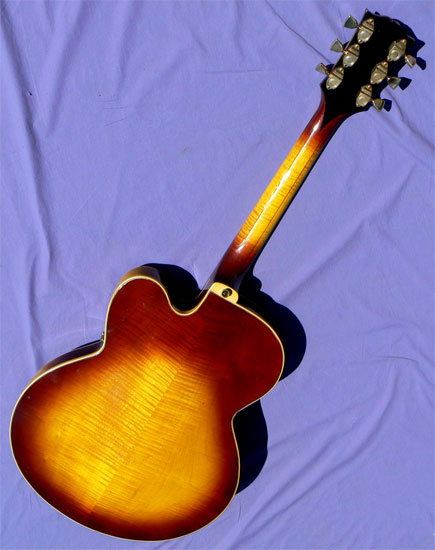
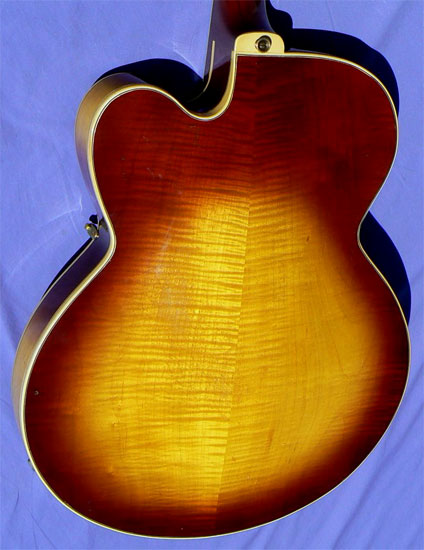
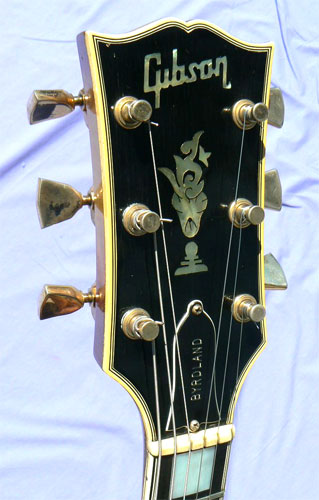
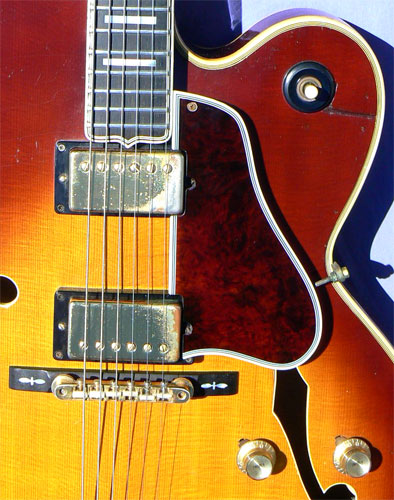
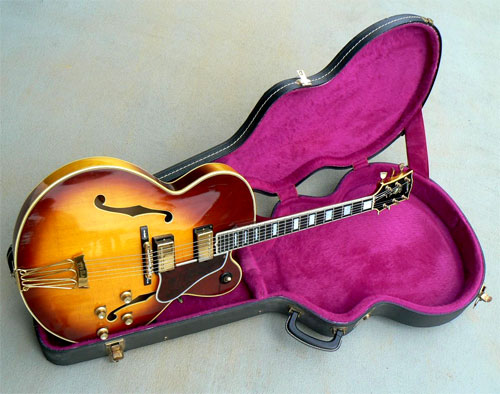
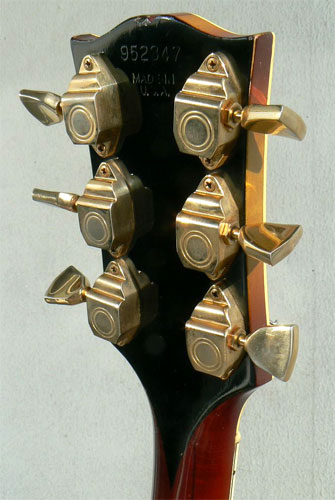 Home / Instruments /Accessories
/ Ordering / Tips / Friends
Home / Instruments /Accessories
/ Ordering / Tips / Friends